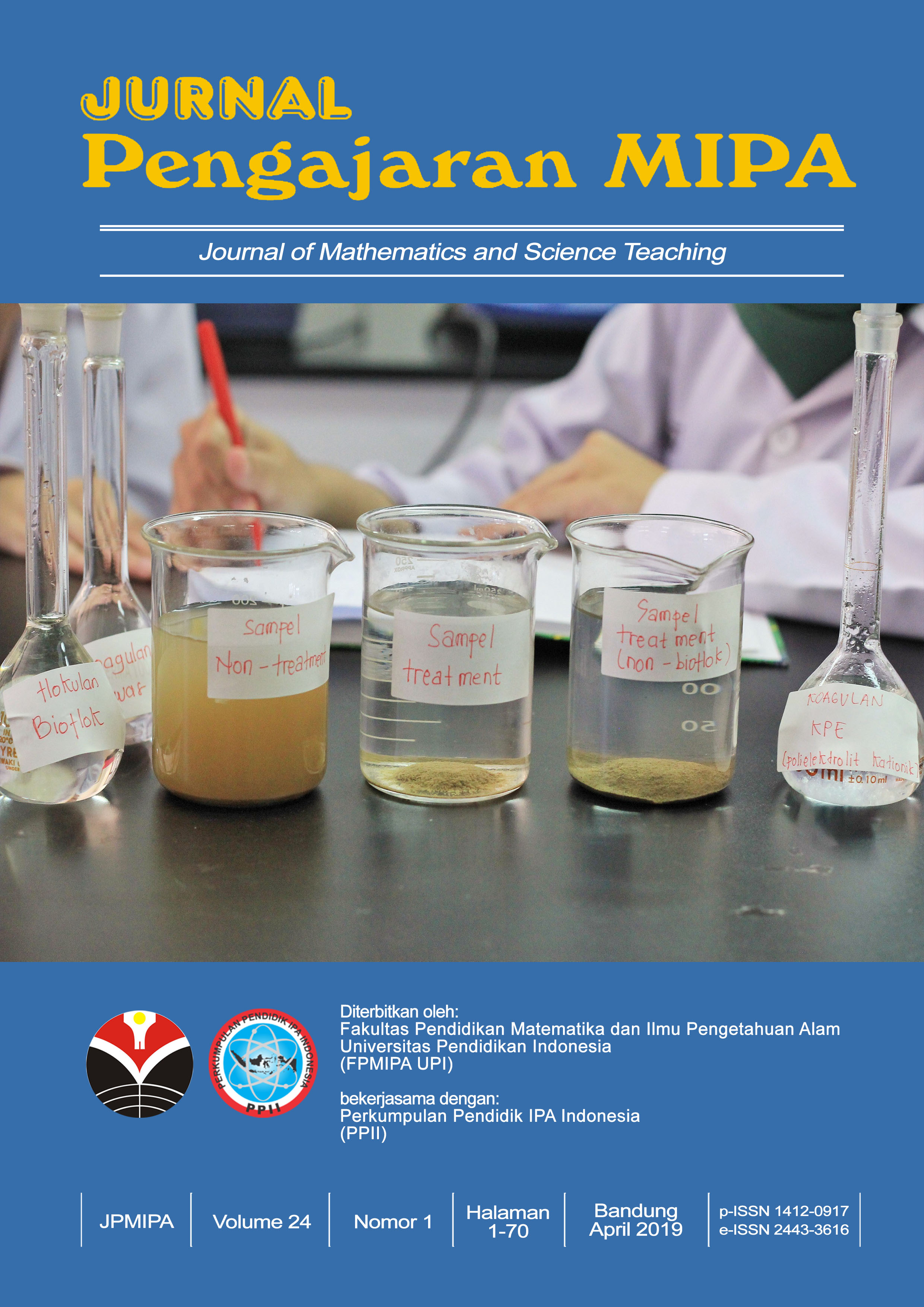EFEKTIVITAS PENGGUNAAN COMPACT DISK (CD) ANIMASI PERKULIAHAN BIOKIMIA UNTUK MENINGKATKAN PENGUASAAN KECAKAPAN GENERIK BIOKIMIA TILIKAN RUANG
Abstract
ABSTRAK
Interaksi biomolekul yang melibatkan enzim umumnya terjadi dalam biokimia terutama dalam metabolisme protein yang untuk memahaminya memerlukan kecakapan generik biokimia (KGB) tilikan ruang. Penggunaan CD animasi dalam perkuliahan biokimia dapat membantu mahasiswa menguasai KGB tilikan ruang. Namun, belum ada publikasi tentang jenis KGB yang dibutuhkan bagi mahasiswa yang dapat membantu menguasai materi biokimia. Penelitian ini bertujuan mengetahui efektifitas penggunaan CD animasi perkuliahan biokimia pada materi metabolisme protin untuk meningkatkan penguasaan KGB tilikan ruang bagi mahasiswa. Penelitian ini divalidasi dengan metode eksperimen pretest-postest one group design pada 52 orang mahasiswa calon guru kimia. Data penelitian terdiri atas data pretes, postes, dan %N-gain. Hasil analisis % N-gain untuk seluruh mahasiswa menunjukkan bahwa rata-rata % N-gain KGB tilikan ruang sebesar 93,20 % lebih tinggi dari rata-rata % N-gain KGB pemodelan sebesar 42,98 %. Padahal, jika dilihat dari perolehan skor rata-rata pretes KGB pemodelan lebih tinggi dari skor rata-rata pretes KGB tilikan ruang. Analisis %N-gain pada kelompok kemampuan mahasiswa juga dilakukan yakni pada kemampuan tinggi (8 orang), kemampuan sedang (32 orang), dan kemampuan rendah (12 orang). Hasilnya, menunjukkan bahwa peningkatan %N-gain penguasaan label KGB tilikan ruang yakni kelompok tinggi (99,8%), kelompok sedang (97,06%), dan kelompok rendah (82,55) lebih tinggi dari peningkatan %N-gain label KGB pemodelan yakni kelompok tinggi (46,98%), kelompok sedang (41,05%), kelompok rendah (40,91%). Uniknya, perolehan rata-rata pretes KGB tilikan ruang lebih rendah dari rata-rata pretes KGB pemodelan, tapi justru peningkatan %-N-gainnya lebih tinggi dari KGB pemodelan untuk semua kelompok kemampuan. Dengan demikian, dapat disimpukan bahwa penggunaan media CD animasi yang dikembangkan dalam perkuliahan biokimia efektif meningkatkan pengusaaan KGB tilikan ruang bagi mahasiswa calon guru kimia.
ABSTRACT
Biomolecular interaction involving enzyme in biochemistry especially protein metabolism need space insight biochemistry generic skills (KGB) to understand. Aplication of animation compact disk (CD) in biochemistry lecture can help student to master the space insight KGB. However, there has been no study on KGB tipe needed by student to facilitate the mastery in biochemistry matter. This research was aimed to investigate the effectivity of animation CD aplication in biochemistry lecture to improve the mastery of Space Insight KGB. The research was validated by experimental method of pretest-postest one group design on fivety two chemistry preservice teachers. The research data consisted of pretest-postest and %N-gain. The result of %N-gain analysis for all student showed that the average of %N-gain space insight KGB was 93,20%; higher than average %N-gain of modelling KGB of 42,98%. Whereas pre-test score of modelling KGB was higher than pre-test average score of space insight KGB. Analysis of %N-gain in student group ability was also carried out namely at high ability (8 students); medium ability (32 students); and low ability (12 students). The result showed the increase of %N-gain of space insight KGB label mastery namely hight group (99,8%), medium group (97,06%), and low group (82,55%) was higher than the increase of %N-gain of modelling KGB label, namely high group (46,98%), medium group (41,05%), and low group (40,91%). Uniquely, achivement of the pre-test average of space insight KGB was lower than the average of modelling KGB pre-test, and the increase of %N-gain was higher than modelling KGB for all groups. Thus, it could be concluded that application of animation CD in bichemistry lecture effectively improved space insight KGB for chemistry preservice teacher.
Keywords
Full Text:
PDFReferences
Gall, M.D., J.P. Gall, & W.R. Borg. (2003). Educational Research, An Introduction. Seventh Edition. Boston : Allyn and Bacon
Mayer, Richard E. & Moreno Roxana. (2002). “Animation as an Aid to Multimedia Learning”. Educational Psychology Review: 14 (1), 145-152.
R.R.Hake (1998). Interactive- Engagement Versus Traditional Methods: A six-Thousand-Student Survey of Mechanics Test Data for Introductory Physics Courses. Am. J. Phys. 66
Shulman, L.S. (1987). Knowledge and Teaching: Foundations of the New Reform. Harvard Educational Review. 57, 1–22.
Teoh, B.S.P & T.K. Neo. (2007). “Interactive Multimedia Learning: Student’s Atitudes And Learning Impact In An Animation Course.” The Turkish Online Journal of Educational Technology ISSN: 1303-6521 6(3).
Thomas, J & Williamson V. (2005). “Molecular Visualization in Science Education”. Journal of Chemistry Education: 82, (6). 937-943
Treagust, D.F., Chittleborough, G, & Mamiala, T.L. (2003). “The Role of Submicroscopic and Symbolic Representations in Chemical Explanations”. International Journal of Science Education, 25, 1353–1368.
White, Brian, Kim, Stella, Sheman, Katerina & Weber, Nicole. (2002). “Multimedia in Biochemistry and Molecular Biology Education. Evaluation of Molecular Visualization Software for Teaching Protein Structure. Differing Outcomes from Lecture and Laboratory”. Biochemistry and Molecular Biology Education: 30 (2), 130-136.
White, Harold. (2011). “Visualizing The Perception Filter and Breaching It with Active-Learning Strategies. Biochemistry and Biology Education: 40 (2), 138-139
DOI: https://doi.org/10.18269/jpmipa.v17i2.36105
Refbacks
- There are currently no refbacks.
Copyright (c) 2021 Jurnal Pengajaran MIPA

This work is licensed under a Creative Commons Attribution-ShareAlike 4.0 International License.
JPMIPA http://ejournal.upi.edu/index.php/jpmipa/index is licensed under a Creative Commons Attribution-ShareAlike 4.0 International License
Jurnal Pengajaran Matematika dan Ilmu Pengetahuan Alam (JPMIPA) or Journal of Mathematics and Science Teaching
All rights reserverd. pISSN 1412-0917 eISSN 2443-3616
Copyright © Faculty of Mathematics and Science Education (FPMIPA) Universitas Pendidikan Indonesia (UPI)
View JPMIPA Stats









